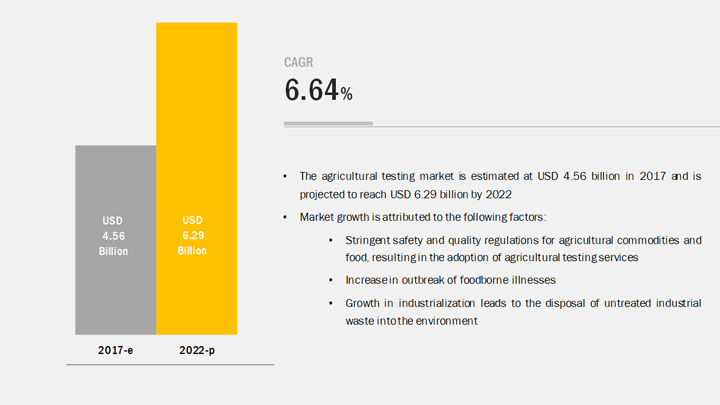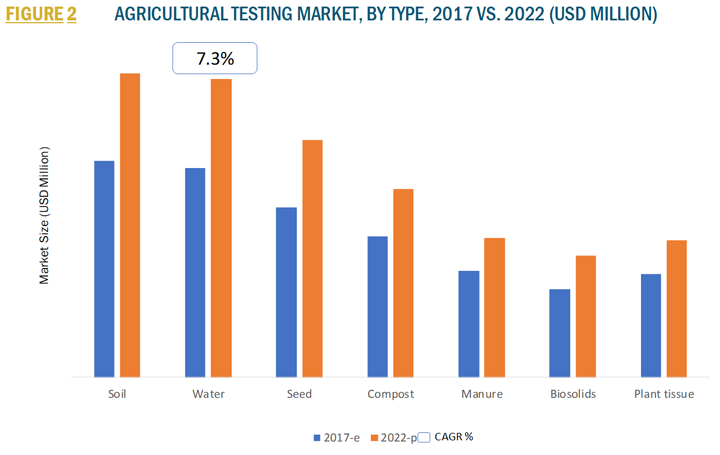The growth in the agricultural testing market is attributed to stringent safety and quality regulations for agricultural commodities and the increase in outbreaks of foodborne illnesses.
Agricultural Testing: Development of New Technologies Leading to Faster and More Accurate Results
Suraj Nagvenkar | Markets & Markets
Lack of coordination between market stakeholders and improper enforcement of regulatory laws & supporting infrastructure in developing economies are the major factors restraining the growth of this market.
Agricultural testing is a part of the testing, inspection, and certification (TIC) industry, which involves the testing of soil, water, seeds, compost, manure, biosolids, and plant tissue samples, not only to ensure the safety of the samples against hazardous contaminants such as pathogens, toxins, pesticides, and heavy metals, but also for the evaluation of quality, composition, and suitability as per the quality of output to be derived from fields.
The growth in the agricultural testing market is attributed to stringent safety and quality regulations for agricultural commodities and the increase in outbreaks of foodborne illnesses. Lack of coordination between market stakeholders and improper enforcement of regulatory laws & supporting infrastructure in developing economies are the major factors restraining the growth of this market. The major types of samples tested for agricultural purposes include soil, water, seed, compost, manure, biosolids, and plant tissues.
Stringency in safety and quality regulations for agricultural commodities and food, resulting in the adoption of agricultural testing services

e - Estimated; p - Projected
Source: Secondary Research, Primary Interviews, Related Research Publications, Industry Journals, Press Releases, MarketsandMarkets Analysis
The agricultural testing market is projected to grow at a CAGR of 6.6% from 2017, to reach a value of USD 6.29 billion by 2022. Among various types of samples tested for agricultural purposes, water is expected to be growing at the fastest rate during the forecast period. Water safety and quality are essential aspects of agriculture, and therefore, the testing of water is important for determining whether it is suitable for agricultural use through irrigation. The demand for water testing is increasing, as it helps in evaluating the quality of water that is used for irrigation, frost cultivation, postharvest cooling, and washing. Furthermore, rapid industrialization in developing countries with improper infrastructure has led to wastewater/effluent discharge from various industrial activities into water bodies without proper treatment, leading to contamination. Irrigation of agricultural fields using contaminated water with toxic elements poses a serious risk to the soil quality as well as the safety and quality of the agricultural produce.

e - Estimated; p - Projected
Source: Secondary Research, Primary Interviews, Related Research Publications, Industry Journals, Press Releases, MarketsandMarkets Analysis
LC, HPLC, and ICP-MS: Faster and more accurate testing solutions
The focus on reducing lead time, sample utilization, cost of testing, and drawbacks associated with several technologies have resulted in the development of new technologies such as spectrometry and chromatography. Increased adoption of these technologies is an opportunity for medium- and small-scale laboratories to expand their service offerings and compete with large market players in the industry, as these technologies offer higher sensitivity, accuracy in results, reliability, and multi-contaminant and non-targeted screening with low turnaround time, among other benefits.
The agricultural testing industry is experiencing technological innovations as major players are offering faster and more accurate technologies such as liquid chromatography (LC), high-performance liquid chromatography (HPLC), and inductively coupled plasma mass spectrometry (ICP-MS) for testing the safety and quality of various agricultural samples. These methods are used in the detection of almost all targets to be tested, including pathogens, pesticides, toxins, and heavy metals. Furthermore, chromatography and spectroscopy are increasingly adopted due to higher sensitivity in comparison to other testing technologies and their ability to detect multiple targets simultaneously.
Procurement costs: High capital investments associated with rapid testing equipment
Instruments and related consumables of high-end technologies such as chromatography and spectrometry used for effective testing of agricultural samples are associated with high costs. Furthermore, an increased focus on R&D activities, coupled with the necessity for accuracy and reliability of readings, increases the costs of these instruments. Since most of these testing instruments are exported in large quantities from developed countries in North America and Europe, it adds to the cost of procuring these technologies, especially in developing economies.
The price of these testing equipment also differs across different parts of the world, with margins varying from 10% to 30% based on the origin of manufacturing. Additionally, consumables used for testing techniques are expensive, which is further increased by an added labor cost. A high capital investment associated with the purchase and installation of such equipment act as huge hindering factors for the market growth by delaying mass adoption of automated testing technologies.
The market for agricultural testing is largely concentrated in Europe, followed by North America, in terms of services provided and used, with the market in these regions being driven by the evolution of modern agricultural testing equipment and adoption of newer technologies, which have helped improve the quality standards of various agricultural products available in the region.
However, emerging economies such as India and China also display a favorable market potential for agricultural testing of soil and water, which have led manufacturers to adopt strategies such as expansions to cater to the growing demand for agricultural testing services and efficient technologies to increase the usage of testing services to improve safety standards in the Asia Pacific region. Furthermore, exports of agricultural produce from these regions are also projected to grow in the coming years, thereby improving the adoption and awareness toward agricultural testing services.
.jpg) About Suraj Nagvenkar
About Suraj Nagvenkar
Suraj holds a degree of Masters of Business Administration (Marketing) from Sinhgad Institutes, Pune (Affiliated to University of Pune) and has completed his graduation in Bachelor of Business Administration (Marketing) from Dynaprassarak Mandal’s College (Affiliated to Goa University), Goa. He holds around 5 years of experience in food & beverage and feed industry, helping industry clients with their business strategies, through market intelligence. His key role in the FnB and Feed domain includes market research and consulting through market evaluation, forecasting, data analysis, competitive analysis, and devising market solutions that are in-line with client’s requirements, facilitating them in their decision-making processes.
The content & opinions in this article are the author’s and do not necessarily represent the views of AgriTechTomorrow
Comments (0)
This post does not have any comments. Be the first to leave a comment below.
Featured Product

